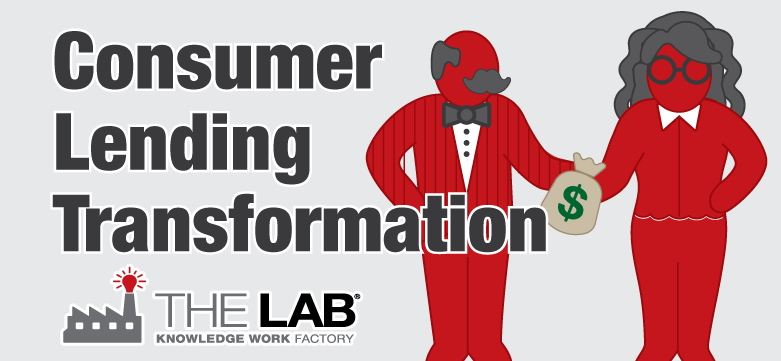Our previous case study peeled back the layers of a wall-to-wall lean HR transformation in banking. This financial services case study, by contrast, tells the story of a leading loan originator and servicer of student loans in the U.S. In this instance, their mandate to transform the entire enterprise to lean operations did not come from the board room. It came from Congress.
For years, this well-known consumer lender had operated as a business-to-business, or B2B, operation. It served banks. The banks, in turn, dealt with the actual student borrowers.
All that, and more, was about to change. A new national healthcare law (you can probably guess which one) prohibited banks from acting as the primary distributors of this financial service operation’s products. Practically overnight, this lender went from B2B to B2C, or business-to-consumer, lending.
But that wasn’t all. Wall Street had this organization in its sights. It needed to make major lean transformation commitments. It had to:
- Cut administrative costs by implementing lean standard lending operations and streamlining all knowledge work processes.
- Improve earnings by transforming the entire financial services operation.
- Vastly improve service through lean business process improvement of customer-facing business units.
- Reduce annual operating expense by at least 25 percent by removing redundant processes and reporting.
- Continue to grow revenue—all while managing the cost-control measures being implemented.
And it needed to accomplish all of the above in just 12 months.
Lean transformation for financial services: Who do you call? The Lab.
Clearly, this was a lean financial services operations transformation of staggering scope: it affected the entire enterprise. It included every business area within the organization. These included, for example:
- Loan origination and servicing.
- Collections operations.
- Contact center operations.
- End-to-end information technology.
- Finance operations.
- Sales and marketing.
- Audit, compliance, and legal operations.
- Human resources.
- Enterprise-wide shared services.
The lending organization in this case study interviewed four of the world’s largest, most prestigious management consulting firms. They went with The Lab due to its deep experience in financial services business process re-engineering.
We leapt in with an eight-week analysis-and-design effort to diagnose what could be transformed in the lender’s operation. This project resulted in the identification of more than 600 lean financial services process improvements that required no new technology to implement. We then established a ten-month lean transformation project work plan. The lean implementation was conducted in two initiatives, with five business areas addressed in each phase, and end-to-end process improvements delivered simultaneously.
Here are just a few of the insights which The Lab revealed during this engagement:
Lean Financial Services Principles Insight 1: Simple “quick hit” lean process improvements and interdepartmental reduce vendor costs
Predictive loan characteristics were analyzed and exploited across the portfolio to create more profitable segments while building revenue, cutting expenses, and reducing defaults.
As it turned out, borrowers were receiving custom one-off collections letters. These were being created daily by the hundreds. Their effectiveness—or lack of—was never measured. They were never standardized prior to The Lab’s work. We changed that. We reviewed all discretionary correspondence. We eliminated overlap. We reduced costs.
Leveraging historical trend data on vendor success and associated cost helped to:
- Drive a 40-percent savings in overall vendor spend.
- Reduce database overlap between lines of business.
- Improve collector productivity.
Lean Financial Services Principles Insight 2: Lack of standard contact-center operations processes increase cost per call, cause back office rework and drive down customer satisfaction
Mis-applied payments hurt customer satisfaction. Payments were mis-applied at three times the comparable average rate—creating unacceptable levels of rework and customer dissatisfaction. Improved lean standard desk level process guides, lean banking quality KPIs and communications standards between contact center and back-office processors helped to eliminate more than half of these errors in 8 weeks.
Meanwhile, in the operation’s contact center, The Lab implemented numerous lean financial services process improvements to improve average handle time, or AHT. These included refinement, standardization and documentation of:
- Call scripts with “decision tree” options.
- Job aids, e.g., for after call work (ACW)
- Productivity reviews – intra-day report outs of capacity utilization
Combined with capacity-planning tools and enhanced techniques for managing representatives, this enabled a 20 percent reduction in AHT at an early checkpoint. And that translated to a 20 percent increase in redeployed capacity.
Lean Financial Services Principles Insight 3: Process improvements in collections drive down Days of Sales Outstanding, increase revenue and reduce employee costs
The new regulations required a lean transformation of all collection processes. Here are just a few of the process improvements which The Lab implemented on this client’s behalf:
- Lean standard process workflows and account segmentation.
- More effective capacity planning.
- Updated representative-management KPIs and metrics to track desk level performance.
All told, these delivered a 14 percent reduction in required headcount for this client’s collections business unit.
Lean Financial Services Principles Insight 4: Shared Services process transformation eliminates redundant processes and cuts cost in the front and back office
- The case of the 5,800 management reports. Obsolete requirements led to redundancy and inefficiency in reporting operations—with 5,800 reports containing different combinations of virtually the same metrics, which no one ever looked at! Scrutinizing the client’s report inventory, The Lab was able to eliminate 25 percent of all existing non-standard reports; the resulting lean finance function reporting rationalization led to a shared services cost reduction of 30 percent.
- Duplicate analysis was killing the organization. Business units and shared-services groups were analyzing the same things, every single week, since no one group trusted the other’s output. The Lab swept in and designed a new lean financial close process that simplified analytics and eliminated redundant one off tools. The savings in administrative costs alone reached $15 million annually.
The Lab delivered lean banking process improvements related to vendor management; we also provided functional realignment in this client’s Finance and Procurement organizations. The result? A 30-percent reduction in associated headcount. That’s a transformation from “outdated and inefficient” to “lean and mean.”
Lean Financial Services Principles Insight 5: Organization redesign reduces lending management costs
When we stepped in, this organization was top-heavy. Due to prior restructurings, there were “departments” featuring two senior managers, managing just two employees, while having two administrative staffers to support them.
To fix these management span opportunities, The Lab employed five different internal and external benchmarking analyses. Our enterprise-wide analysis of this client’s reporting relationships took into account numerous factors, such as:
- Internal and external organizational benchmark analysis.
- Continuous improvement tools for financial services management spans analysis.
- Future state operating model redesign implementation.
Taken together, the lean organizational redesign project resulted in $36 million in management reductions, helping to reduce costly positions by 12 percent.
The results: A financial services operation implements lean management—and adds almost 50 percent to its stock price as a result
A lot happened, and fast. Consider these numbers:
- Operating cost dropped 25 percent.
- Annual operating savings reached $150 million.
- Over four quarters, the stock price rose almost 50%
But that wasn’t all. The lean financial services operations consulting implementation broke even in just five months. By Month 12, payback on the business process redesign investment in The Lab reached five-fold.
And we mentioned above that Wall Street was watching. Boy was it ever. As the client hit its earnings goals, its stock price rose more than 40 percent.
An enterprise-wide lean transformation in consumer financial services operations may be a daunting undertaking, but it can be done right—with surprising speed and savings. Learn more about how The Lab undertakes these types of challenges everyday, including our unique self-funding business process transformation engagement model and money-back guarantee.
Real results. Real fast.
The Lab can get your first banking bot up and running in just weeks. It’s an irresistible offer, made all the more enticing by the fact that you don’t have to force this change on your workforce. Once they see it in action, they’ll be clamoring for more.
Call The Lab at (201) 526-1200 or email info@thelabconsulting.com today for your free, no-obligation 30-minute screen-sharing demo. You’ll love it!
For 2021: We have updated our bank client offering. Much of these findings and implementation results can be reviewed in the 3-part-series of “Big Rocks for Banks” below. Find out how to strategically lower costs, increase operating leverage, improve customer experience, and automate what previously wasn’t automatable in your bank.
Find them all here:





















